This is a review of the Sekonic Twinmate L-208. A small reflective and incident reading light meter with a design and user interface that harks back to traditional light meters. It can be handheld, carried on a lanyard around the neck, and also mounted to the top of a camera with a shoe mount – this versatility is why I wanted to review it.
If you follow this website, you will know I have reviewed a lot of shoe mount meters. I don’t really know how I fell into doing this, but I did, and I have found it hard to stop. It is quite interesting seeing how various companies have tried to compete with each other over the last few years. Some have gone for simplicity of functionality, some for lots of features, some for speed of use, and others have prioritised small size. There has been something of a flurry of meters coming to market with brands popping up from Canada, Germany and (a fair few from) China. Whilst many of these new meters offer features and tech that just didn’t exist on the market even just a few years ago, light meters as technology have, of course, been around for many years before. Sekonic has been going since the 1950s.
I’m not going to regale you with a history of the brand – you can find that sort of info elsewhere online, I’m sure. I mention it simply to point out that the Sekonic Twinmate L-208 comes from a brand that has been around the block a few times. They have a good variety of meters on the market too, ranging from the very simple L-208 to the much more feature heavy L-858 meters. I personally never need anything more than the basics in my work. I just don’t need a complicated, feature packed light meter for any part of my photography. Which is a shame in a way, as I do like the look of a lot of the Sekonic range, I just have no need for the extent of features many of the higher end models provide.
In fact, for the most part I could just get away with my iPhone. The Lumu app is great, and is accurate. The issue is, I don’t like using my phone as a meter. It feels clumsy. Which is why, I suppose, I fell into the rabbit hole of playing with shoe mount meters – small simple meters with a basic feature set appeal to my simple approach to metering. Especially as really, I mostly use light meters to supplement guess work rather than entirely relying on them for every shot. I also like the fact that I can mount them and use them on the camera, but they are all nice and small so I can also just chuck them in a pocket and use them hand held without feeling like I’m carrying any extra bulk at all.
That all said, there are occasions when I like to spot meter or make use of an incident meter. The former I rarely use, but have a Pentax meter for the times I want to. The latter I haven’t entirely settled on a solution for. I’ve tried a few older meters such as the Weston Master V which is a beautiful thing, and I really enjoy the user experience, but I had a couple fail on me so I stopped trying to find a working one. I had a Lumu meter to plug into my iPhone, but for the same reasons as not liking the app by itself I stopped using that too. I’ve even had a Sekonic L-398, which was a lovely thing but for reasons I forget, I sold it – I think I might have found it too big.
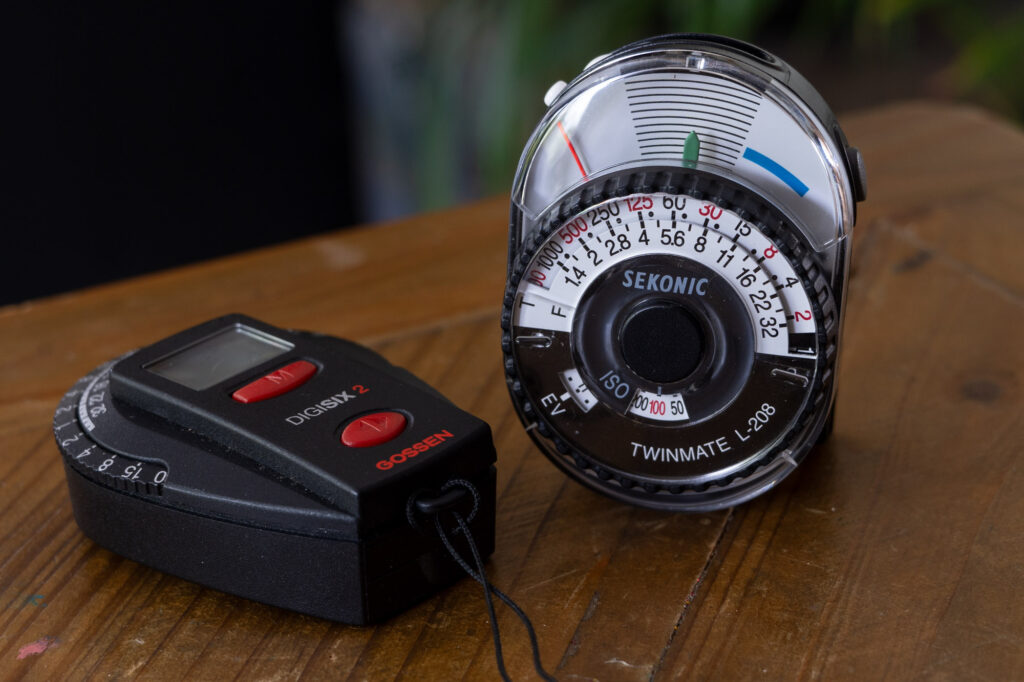
I also have a Gossen Digisix 2. The Digisix 2 is Gossen’s answer to the Sekonic Twinmate L-208. It’s a similar size, but has a digital readout. It’s a nice little meter in many ways, but I’ve never completely gelled with it. I will get around to reviewing it properly at some point, but in short I have found it a little fiddly to use. I always have to hunt out the instructions to remember how to use it, I don’t really enjoy the little digital readout, and quite often when I dig it out to use, the battery is flat. I had this exact experience with it recently when preparing to shoot an event I’d been asked to cover on film. I knew I was going to be shooting in an oddly lit room so decided to take both an incident meter and the Pentax spot. The night before I picked up the Pentax and even having not used it for a while it fired up without issue. The Gossen was dead, so I had to go out hunting for a battery in a supermarket on the way to the event. It was then I decided I must get myself another incident meter that I was happier with. That said, the actual experience of shooting with an incident meter was very satisfying. I found myself scoping out the room to check the variance in lighting before it filled up with people, and was then able to shoot without having to recheck the light for much of the event. The results came out great too. I also really liked the small size, and being able to carry it on a lanyard around my neck kept it really nicely to hand.
In the end, this sort of dissuaded me from thinking about a new meter – it had done the job once I was there, and I don’t use incident meters that often, so I decided against getting a new one. As such, I didn’t really think about it again until a representative working for Sekonic got in touch to ask if I might be interested in reviewing one of their meters. I was a little reluctant to begin with – I’d tried the L-398 before so wasn’t really that fussed to review it, but then when I had a look at their range I spotted the Sekonic Twinmate L-208. It’s a meter that’s been highlighted to me before by people who have read my shoe mount meter reviews, but thinking it might just be a bit big for shoe mounting, I sort of dismissed it. But, now having had the experience of success using the Gossen despite its shortfalls, the Sekonic Twinmate L-208 all of a sudden seemed really appealing.
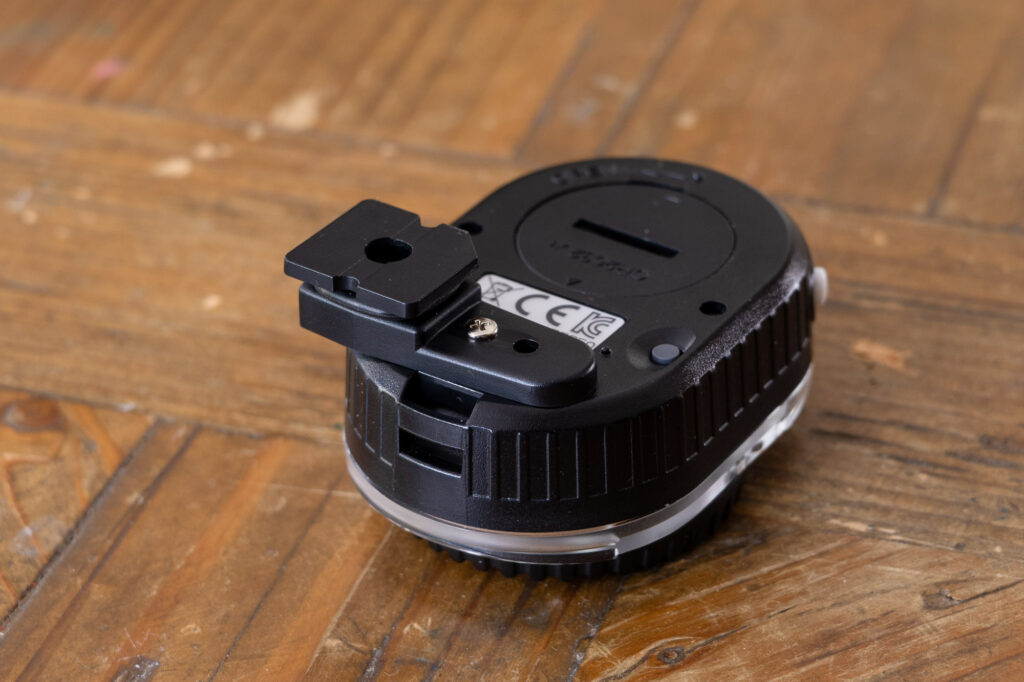
The Sekonic Twinmate L-208 – in theory
Excuse the long introduction there, but I thought it might help contextualise the potential appeal of the Sekonic Twinmate L-208. Looking at the pictures of it, I realised it might actually tick a whole load of boxes for me. For a start, it can be camera mounted, handheld and carried on a lanyard. I like my shoe mount meters, but as I have said I often find myself hand-holding and pocketing them. Since shooting that event I’ve also had a hankering for a meter that I can carry on a lanyard. I mentioned this in my review of the Astrhori XH-2 meter – had that a loop for attaching a lanyard it felt like it would have made a lot more sense to me as a bit of kit. Though of course, it is just a reflective meter so it wouldn’t have solved my desire to replace the Gossen. As such, add the ways the Sekonic Twinmate L-208 can be carried to the fact that it has a traditional user experience and readout, and has both reflective and incident metering options… well, you can perhaps see why my interest was piqued. I agreed to review it, and a few months later I now have some in-practice thoughts to share.
The Sekonic Twinmate L-208 – in practice
My first impressions of the Sekonic Twinmate L-208 were pretty positive, or at least they were pretty much bang on what I expected to find. This meter is not particularly expensive, so I didn’t expect it to have the heft and feel of meters like the old Western Master V. In fact, by comparison it is very light. The whole outer shell is made of plastic which gives it a slightly hollow feel. Though, none of this is to say it feels cheap or not well made, not by any stretch really. The base of the meter is made of black plastic and the face black and clear plastic. The lower part of the front of the meter is the settings dial, the top has a readout window with a needle that swings back and forth when the metering button on the side is pressed. There’s also a battery test button on the bottom. On the top of the meter there’s a sliding white dome that allows the meter to be switched between reflective and incident metering modes. In short, it’s a simple design with no superfluous frills.
It’s very simple to operate too. First set the exposure index (ISO) by rotating the face of the dial. There’s two protruding bits of plastic to assist its rotation. Once set there’s the option of either reflective metering or incident metering.
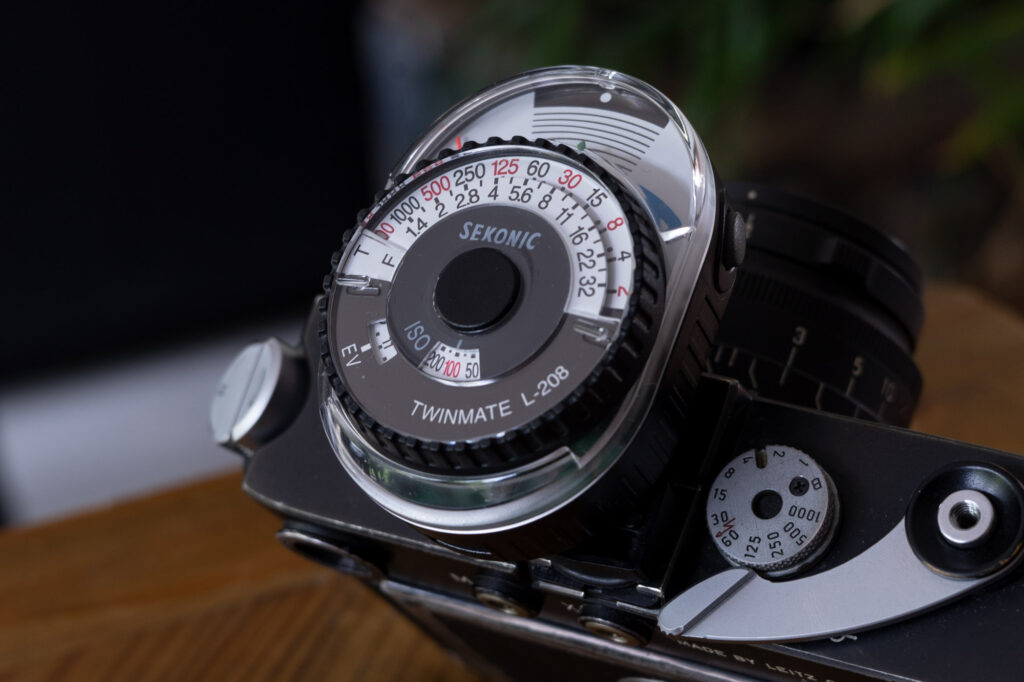
Reflective metering
To use the meter in reflective mode, the little white dome needs to be slid out of the way of the light receptor. Then, simply pointing the meter at the subject or whatever is to be metered off, and click the metering button gives a reading. The orange metering needle very quickly swings out to give a reading which is locked in place once the button is released. The main dial is then rotated so the green arrow matches the position of the orange metering needle.
Once the green arrow is lined up, any of the corresponding matched settings can be applied to the camera for correct exposure. There’s also an EV window that shows an EV readout that’s relative to the set ISO – useful for folks with Hasselblads and the like which have EV numbers on their lenses… or just for people who like to know what EV they are working with.
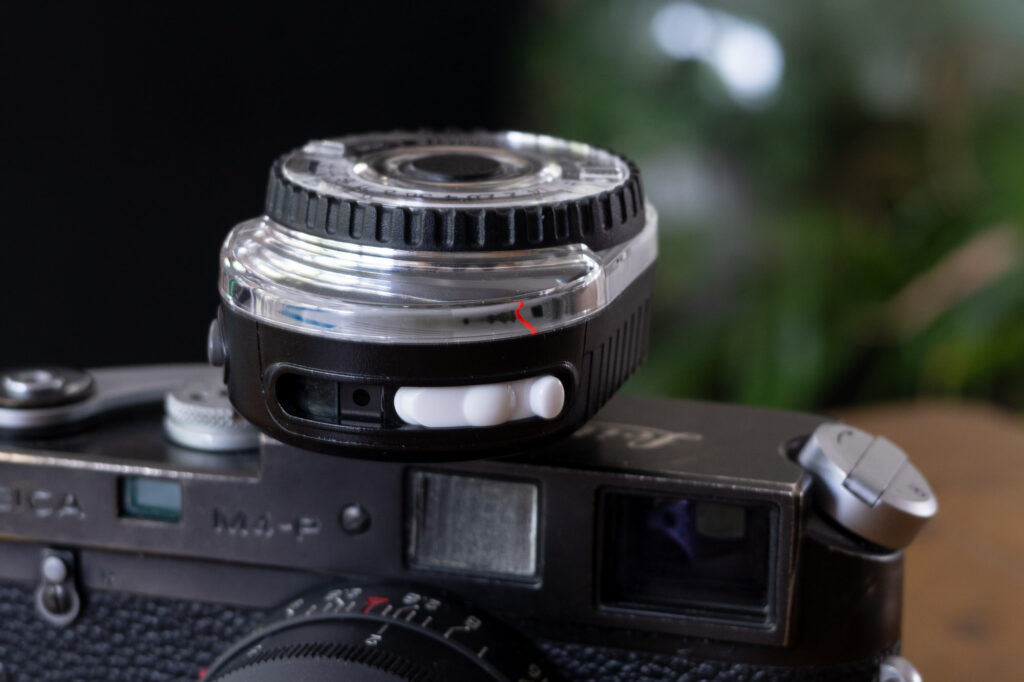
Incident metering
The Sekonic Twinmate L-208 works exactly the same way in incident mode. The white dome is slid in front of the light receptor and the meter can be used to incident meter instead. The rest of the functionality is the same. Press the button to take a reading, set the green pin the match the orange one and pick a combination of setting to apply to the camera.
Holding and using the Sekonic Twinmate L208
What I find particularly pleasing about the Sekonic Twinmate L-208 is that whilst it’s just a fairly un-ergonomic, small oval shape, I can still use it without any trouble with one hand. It’s also a damn slight more easy to hold and use with one hand than any of the little dedicated shoe mount meters which often feel a little fiddly to use hand held. All the setting can be adjusted, the reading button pressed and even the white dome slid back and forth with ease with either hand. I don’t always have a strap on my cameras, so this is particularly helpful to me. One hand carrying camera, whilst the other holds the meter and takes a reading. Because it’s small it goes in a pocket with ease too – this is how I have carried it for the most part in fact.
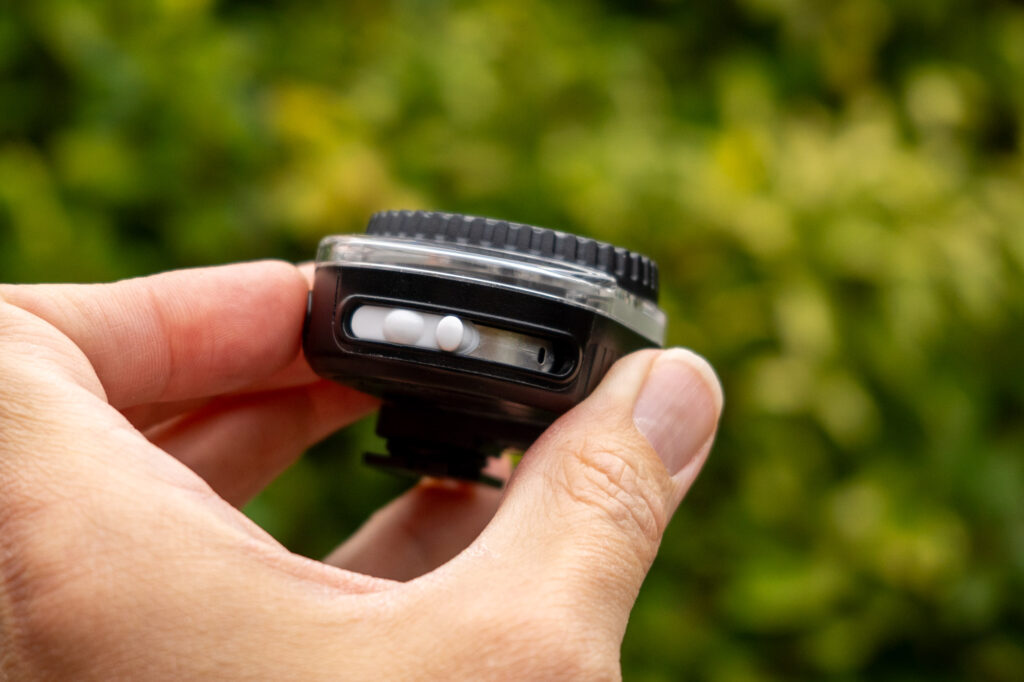
As mentioned, it also has a shoe mount for allowing it to be mounted onto the top of a camera too. The shoe mount comes in the box separately meaning it needs to be screwed to the body of the meter. Once attached it takes away something of the neatness of the design of the meter and makes it feel a little bigger, though not much. The shoe mount is made of plastic too and comes in one size meaning it isn’t going to be universally compatible with all cameras. To remedy this, Sekonic includes a small rubber band which goes around the neck of the shoe mount to help it securely mount to cameras. This actually works really well, but it does give me some concerns about longevity. At some point, I would assume the band would wear out and need replacing.
There’s also a place to attach a lanyard near the base of where the shoe mount is fixed. The lanyard included is far too long for my tastes though. I suppose I could tie a knot in it to make it shorter, but instead I’ve swapped it for the shorter one that came with the Gossen. I actually have a couple of lanyard style straps with single Peak Design anchor link things on somewhere, and my intention is to dig one of those out allowing my to quickly unclip it from a strap and attach it to my camera or hand-hold it.
The elephant on the camera
As I said at the beginning of this review, I was interested in the Sekonic Twinmate L-208 for how versatile it is. Small enough to pocket, light enough for a lanyard… and a shoe mount too… Ok, I’ve breezed over this a little bit so far, but it’s fair to say that it is not exactly small when compared to even the biggest of the more recent flurry of shoe mount meters. In fact, when mounted, it looks pretty huge relative to pretty much any of my film cameras.
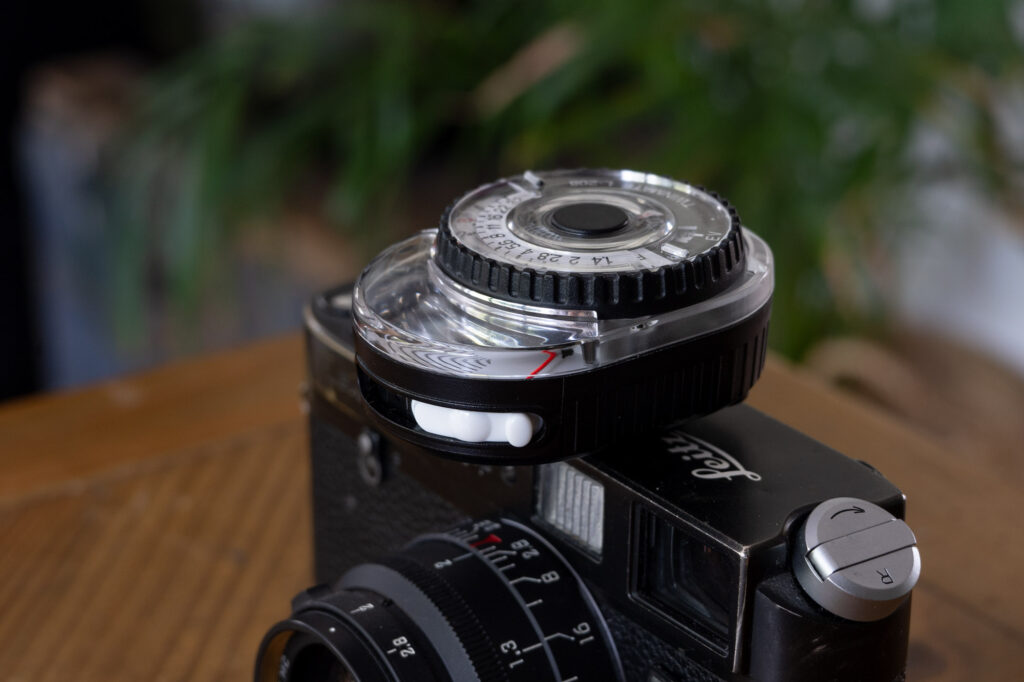
I think the shoe mount nature of it is a little more nuanced than just how it looks on the camera though. It is bulky for sure, but it still works well as a shoe mount meter inasmuch as it still points in the right direction when in reflective mode, and still takes accurate readings etc.
What I have found in practice though is that I never really set out to use it permanently mounted on the camera. I have used it this way, but more often than not I find myself taking it on and off the camera whilst out. Mounting it on the camera has for me become another convenient place to put it and occasionally use it. It does look almost a little daft on the camera, but when I’m out taking photos how the camera looks is of zero relevance to me. Convenience and function are what matters, and the Sekonic Twinmate L-208 brings both!
The battery
The Sekonic Twinmate L-208 works with a single CR2032 battery. This will no doubt please the folks who usually express concern at the current craze for making everything USB rechargeable. Hopefully it will also save my from the argument about e-waste in the comments too… unless anone wants to talk about the dangers of button cells when swallowed…? I digress, I’ve not had it long enough to determine how long the battery lasts, but unlike the Gossen, the Sekonic Twinmate L-208 doesn’t stay on all the time, so isn’t constantly draining the battery. In fact, it only uses battery when a reading is taken so I’d expect it to last a very long time. It also has a battery test mode. There’s a button on the base of the meter that when pressed sends the meter read needle into somewhere within the zone on the readout face marked in blue. The further up that line, the better the battery. Since I have had it, when pressing the battery test button on the bottom, the lever shows no sign of any battery drain whatsoever.
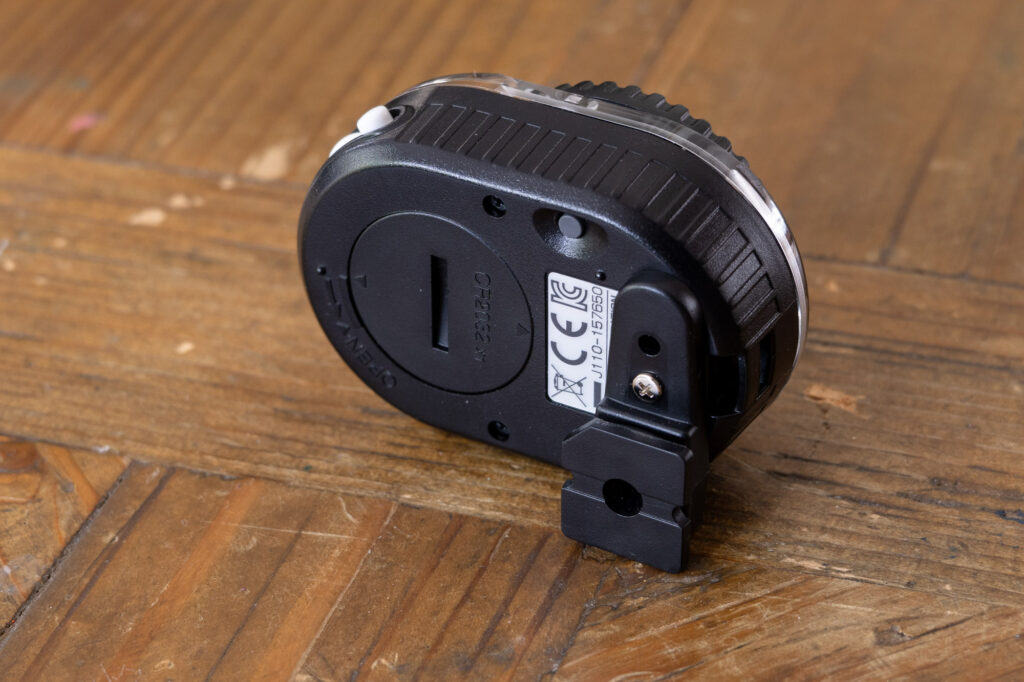
Specs
The reading scale has settings from f/1.4 – f/32, 30secs – 1/8000th and ISO range from 12500 – 12 ISO. All the numbers represented on the reading scales are full stops, but there are intermediate numbers represented by dots between the numbers as illustrated in the manual. The intermediate numbers are interesting too as rather than show 1/2 or 1/3 stops they have chosen to indicate numbers used on older cameras from before the modern standards were adopted.

The Sekonic Twinmate L-208 also has a metering range from EV3 to EV17 at 100ISO. This means it might not be the best choice for especially low light usage, but for anything within daylight, dusk, indoors within normal household lighting it’s probably going to be fine.
Final thoughts
As you can possibly tell, I really like the Sekonic Twinmate L-208. It is a very basic meter with nothing in the way of superfluous frills, and isn’t going to be particularly useful in low-low light. It has no functionality for flash photographers and some will find its light weight plastic build off putting I’d imagine – especially if you hold it up against classic meters such as the Weston Master 5.
What it does bring to the table though has been pretty compelling for someone who works like I do. I have spent the last few years fiddling with shoe mount meters mostly for their tiny size. As I’ve said, I’m the type to supplement guess work with a meter rather than metering for every shot. I also don’t like carrying too much kit around with me. So having something so small that it practically disappears into a pocket or can be mounted on a camera high on my priority list. The Sekonic Twinmate L-208 fits that bill, but adds practicality, both incident and reflective metering and a meter readout that I enjoy working with. In short, I think this is great light meter, and having reviewed it, I now own one and I believe it is going to get a lot of use!
You can find out more about the Sekonic Twinmate L-208 here
Share this post:
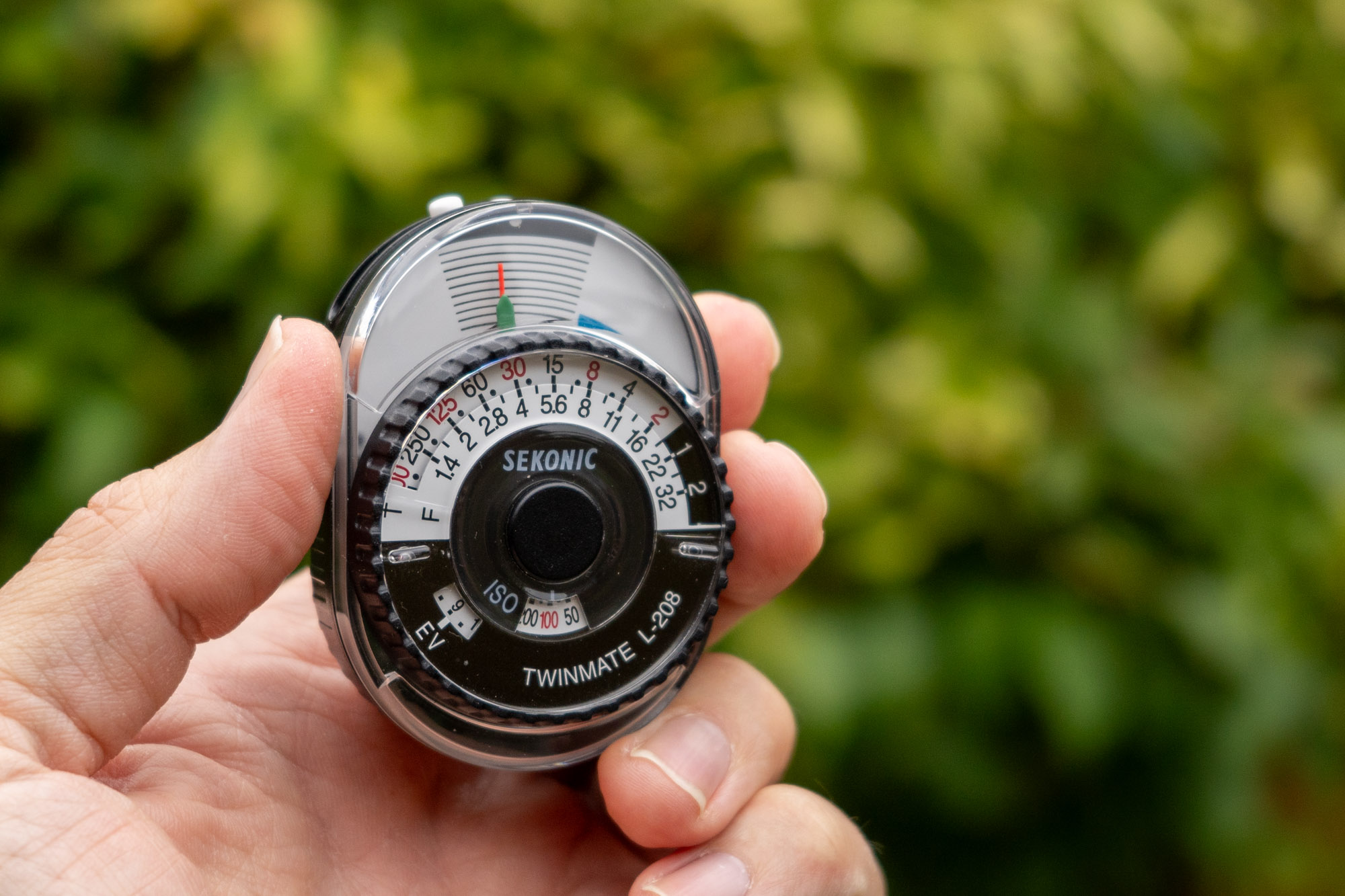
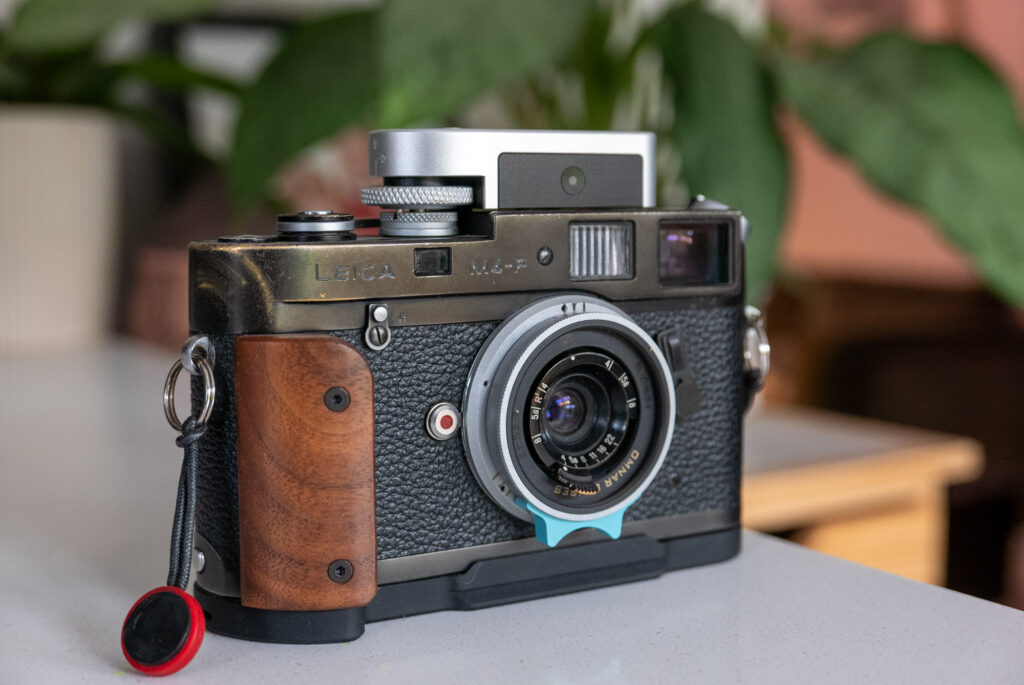
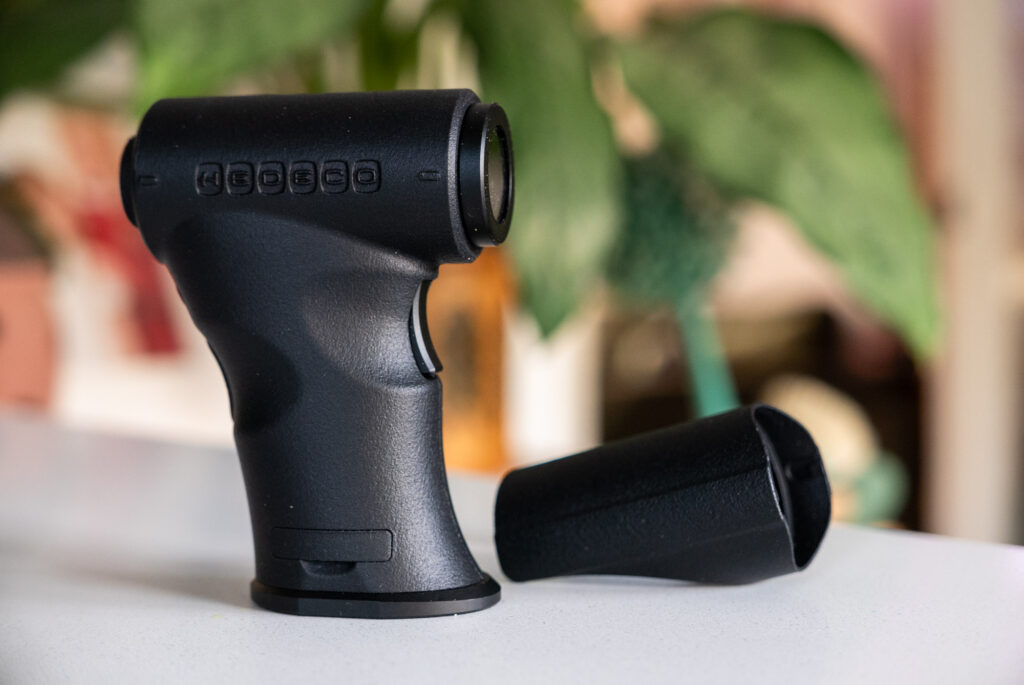
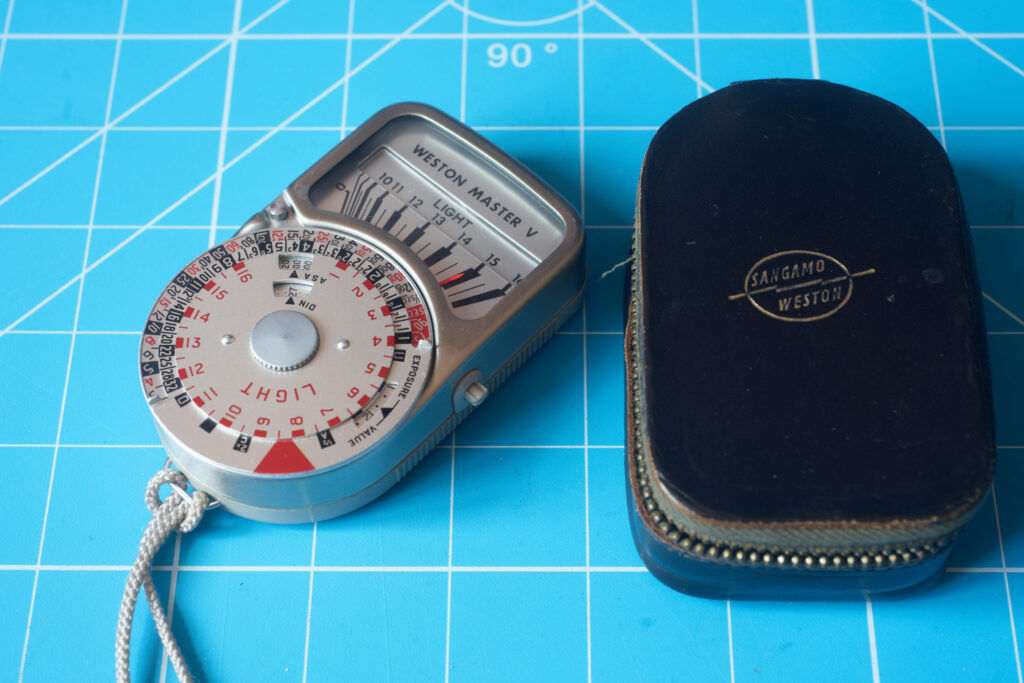
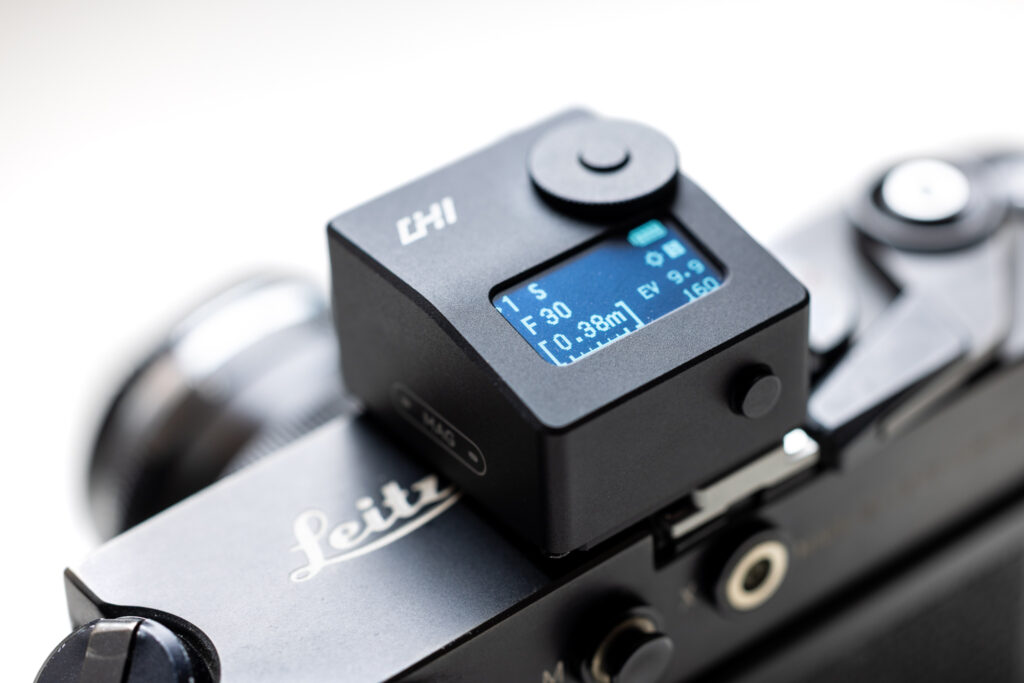




Comments
Jeffery Luhn on Sekonic Twinmate L-208 – A very versatile little light meter
Comment posted: 07/10/2024
Thank you for another great meter review. I read your other reviews of various shoemount meters and bought the KEKS KMO2. The display is tiny! So much so, that I had difficulty using it in some lighting conditions. Since I use it infrequently, I forget the button sequence too, which is on me, I know. Then I bought a used Gossen Luna 6, which is almost identical to my first 'grown up' meter, the Luna Pro. Big, accurate, easy. But having it around my neck is awkward. So I'm glad you reviewed this small Sekonic, which is from a company I trust. It may be a convenient solution for me. Thank you!
Comment posted: 07/10/2024
Steviemac on Sekonic Twinmate L-208 – A very versatile little light meter
Comment posted: 07/10/2024
Erik Brammer on Sekonic Twinmate L-208 – A very versatile little light meter
Comment posted: 07/10/2024
Speaking of meter readings: I think there is a reason why most cars still have analog readings for e.g. speedometers (no matter how much they are driven digitally internally, I reckon). They are quicker to read, even at a glance, and provide context - in light meters that would be the different aperture and shutter speed combinations giving you the same exposure.
The Pentax Digital Spotmeter has that initial digital readout of EV, but from there it’s all analog dials again. For a very good reason, in my personal view.
Comment posted: 07/10/2024
Comment posted: 07/10/2024
Gert-Jan on Sekonic Twinmate L-208 – A very versatile little light meter
Comment posted: 07/10/2024
Comment posted: 07/10/2024
Comment posted: 07/10/2024
Phil Harrison on Sekonic Twinmate L-208 – A very versatile little light meter
Comment posted: 07/10/2024
Comment posted: 07/10/2024
Menno Stormink on Sekonic Twinmate L-208 – A very versatile little light meter
Comment posted: 07/10/2024
Like you mentioned one of the nice things about the Sekonic is it simple use and the ability to use it one handed.
I did noticed 2 flaws and 1 point of attention.
The point of attention is that during reflective measuring it can be to sensitive and measure the sky, so be careful pointing the Sekonic.
A minor flaw is that after years of use the 2 needles interfere with each other ,they catch each other.
A mayor flaw is that the iso dial moves to easily, so whenever I take out the lightmeter the ISO dial has moved.
But all things considered, it is my favorite meter.
Comment posted: 07/10/2024
Alan Simpson on Sekonic Twinmate L-208 – A very versatile little light meter
Comment posted: 08/10/2024
John Andrews on Sekonic Twinmate L-208 – A very versatile little light meter
Comment posted: 08/10/2024
Juna on Sekonic Twinmate L-208 – A very versatile little light meter
Comment posted: 08/10/2024
Nevertheless, I also make use of shoe mount lightmeters like the first by reveni labs, the Hedeco or even the Voigtländer labeled one, especially in dark german winter time. But usually I go Sunny 16 by now. If it's important though, always have the twinmate ready...
Daniel Castelli on Sekonic Twinmate L-208 – A very versatile little light meter
Comment posted: 09/10/2024
I tried the shoe mount accessory, but it just looked awkward on my M2. It ruined the classic mid-50’s German design look. But that’s only me.
Dan
Comment posted: 09/10/2024
Comment posted: 09/10/2024
Leon Winnert on Sekonic Twinmate L-208 – A very versatile little light meter
Comment posted: 09/10/2024
Calibrated the Twinmate against my Fuji XT1 and Nikon Df lightmeters. Twinmate consistantly over exposes by 1 stop. Solution, set ISO value to half of what your film's rating is. i.e for ISO 400 film set is at 200.
Like other commentators I too have noted that he ISO setting moves. I put this down to a low level of friction in the adjustment mechanism. Does it move when the Twinmate is knocked? I don't think so. More a case of because of the low friction in the setting wheel it is susceptable to wandering off whan a hand is placed around the Twinmate when say you put it in or extract it from your pocket or what ever.
Solution? Don't assume check! Before every use check that the ISO value is correctly set.
Other than that great little gadget. Thourghly reccommended
Comment posted: 09/10/2024